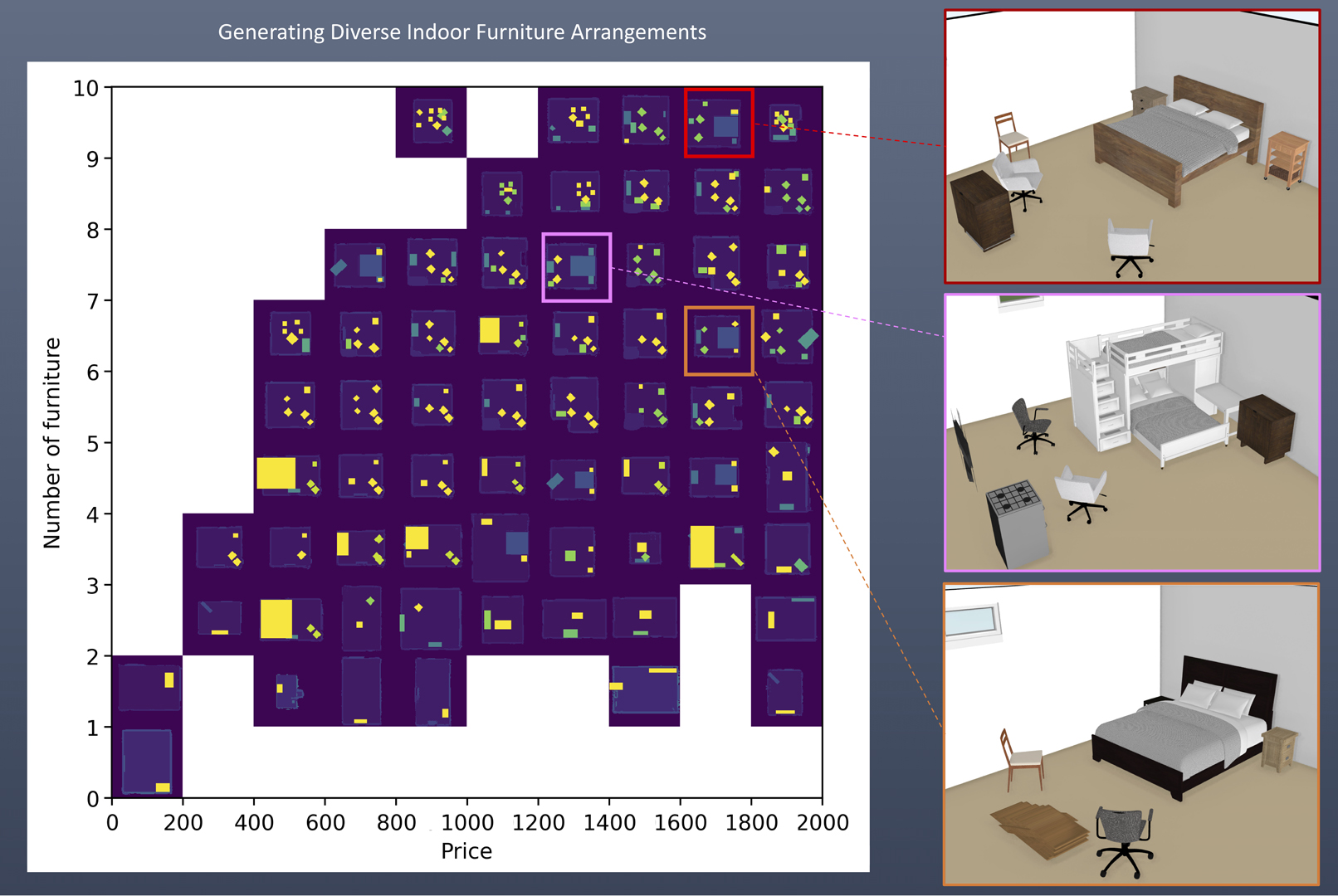“Generating Diverse Indoor Furniture Arrangements” by Hsu, Nikolaidis, Fontaine, Earle, Edwards, et al. …
Conference:
Type(s):
Title:
- Generating Diverse Indoor Furniture Arrangements
Presenter(s)/Author(s):
Entry Number: 60
Abstract:
We present a method for generating arrangements of indoor furniture from human-designed furniture layout data. Our method creates arrangements that target specified diversity, such as the total price of all furniture in the room and the number of pieces placed. To generate realistic furniture arrangement, we train a generative adversarial network (GAN) on human-designed layouts. To target specific diversity in the arrangements, we optimize the latent space of the GAN via a quality diversity algorithm to generate a diverse arrangement collection. Experiments show our approach discovers a set of arrangements that are similar to human-designed layouts but varies in price and number of furniture pieces.
References:
Daniel Cer, Yinfei Yang, Sheng-yi Kong, Nan Hua, Nicole Limtiaco, Rhomni St John, Noah Constant, Mario Guajardo-Cespedes, Steve Yuan, Chris Tar, 2018. Universal sentence encoder. arXiv preprint arXiv:1803.11175(2018).Google Scholar
Matthew Fontaine, Sophie Hsu, Yulun Zhang, Bryon Tjanaka, and Stefanos Nikolaidis. 2021a. On the importance of environments in human-robot coordination. Robotics: Science and Systems (RSS)(2021).Google Scholar
Matthew C Fontaine, Ruilin Liu, Julian Togelius, Amy K Hoover, and Stefanos Nikolaidis. 2021b. Illuminating mario scenes in the latent space of a generative adversarial network. In Proceedings of the AAAI Conference on Artificial Intelligence (2021).Google ScholarCross Ref
Matthew C Fontaine, Julian Togelius, Stefanos Nikolaidis, and Amy K Hoover. 2020. Covariance matrix adaptation for the rapid illumination of behavior space. In Proceedings of the 2020 genetic and evolutionary computation conference. 94–102.Google ScholarDigital Library
Qiang Fu, Xiaowu Chen, Xiaotian Wang, Sijia Wen, Bin Zhou, and Hongbo Fu. 2017. Adaptive synthesis of indoor scenes via activity-associated object relation graphs. ACM Transactions on Graphics (TOG) 36, 6 (2017), 1–13.Google ScholarDigital Library
Tero Karras, Miika Aittala, Samuli Laine, Erik Härkönen, Janne Hellsten, Jaakko Lehtinen, and Timo Aila. 2021. Alias-free generative adversarial networks. Advances in Neural Information Processing Systems 34 (2021).Google Scholar
Despoina Paschalidou, Amlan Kar, Maria Shugrina, Karsten Kreis, Andreas Geiger, and Sanja Fidler. 2021. ATISS: Autoregressive Transformers for Indoor Scene Synthesis. Advances in Neural Information Processing Systems 34 (2021).Google Scholar
Justin K Pugh, Lisa B Soros, Paul A Szerlip, and Kenneth O Stanley. 2015. Confronting the challenge of quality diversity. In GECCO.Google Scholar
Laurens Van der Maaten and Geoffrey Hinton. 2008. Visualizing data using t-SNE.Journal of machine learning research 9, 11 (2008).Google Scholar
Kai Wang, Manolis Savva, Angel X Chang, and Daniel Ritchie. 2018. Deep convolutional priors for indoor scene synthesis. TOG (2018).Google Scholar
Hejia Zhang, Matthew Fontaine, Amy Hoover, Julian Togelius, Bistra Dilkina, and Stefanos Nikolaidis. 2020. Video Game Level Repair via Mixed Integer Linear Programming. In Proceedings of the AAAI Conference on Artificial Intelligence and Interactive Digital Entertainment, Vol. 16. 151–158.Google ScholarCross Ref





